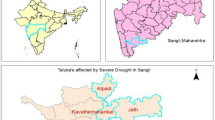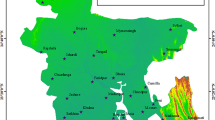Abstract
Agricultural drought refers to soil moisture deficit, which causes adverse effects on the crop production and economy of a nation. This work compared the capability of artificial neural network (ANN) and support vector machine (SVM) algorithm in predicting agricultural drought in the Palakkad district of Kerala, India. Also, the influence of various global climatic indices on soil moisture stress in the study area is assessed. Two models were developed to investigate the impact of global climatic indices. Model 1 considered only local meteorological variables as predictors, and model 2 included global climatic indices along with meteorological variables. The results showed that ENSO has commendable influence on the early prediction of agricultural drought in Palakkad and are more evident at higher lead times (2 to 4 months). For the first model of ANN and SVM, the R2 values at a 4-month lead range from 0.56 to 0.76 and 0.62 to 0.77, respectively. Similarly, for model 2, the R2 varies from 0.61 to 0.77 and 0.75 to 0.82 for ANN and SVM models, respectively. Further, the results indicated that the SVM model shows clear advancement in prediction over ANN especially at higher lead times, even though both show a comparable performance at 1-month lead time. The study provided useful information regarding the potential predictors of agricultural drought in the study area and suggest suitable models for the early prediction. This will support the decision makers in drought prevention and water resource management.






Similar content being viewed by others
Data availability
The gridded rainfall and temperature data were obtained from the India Meteorological Department (available at https://www.imdpune.gov.in). The monthly time series values of root zone soil moisture, specific humidity, and wind speed were acquired from NASA GLDAS (available at https://disc.gsfc.nasa.gov). The monthly values of various climatic indices were downloaded from http://psl.noaa.gov and http://www.bom.gov.au.
References
Abhilash S, Krishnakumar EK, Vijaykumar P, Sahai AK, Chakrapani B, Gopinath G (2019) Changing Characteristics of Droughts over Kerala, India : Inter-Annual Variability and Trend. Asia-Pac J Atmos Sci 55:1–17
Borji M, Malekian A, Salajegheh A, Ghadimi M (2016) Multi-time-scale analysis of hydrological drought forecasting using support vector regression ( SVR ) and artificial neural networks (ANN). Arab J Geosci 9:725. https://doi.org/10.1007/s12517-016-2750-x
Chiew FHS, Piechota TC, Dracup JA, Mcmahon TA (1998) E1 Nino / Southern Oscillation and Australian rainfall, streamflow and drought : Links and potential for forecasting. J Hydrol 204:138–149
Dikshit A, Pradhan B, Alamri A M (2021) Long lead time drought forecasting using lagged climate variables and a stacked long short-term memory model. Sci Total Environ 755. https://doi.org/10.1016/j.scitotenv.2020.142638
Dutta D, Kundu A, Patel NR (2013) Predicting agricultural drought in eastern Rajasthan of India using NDVI and standardized precipitation index. Geocarto Int 28(3):192–209. https://doi.org/10.1080/10106049.2012.679975
Erol Keskin M, Terzi Ö, Dilek Taylan E, Küçükyaman D (2011) Meteorological drought analysis using artificial neural networks. Sci Res Essays 6(21):4469–4477. https://doi.org/10.5897/sre10.1022
Fausett LV (2006) Fundamentals of Neural Networks: Architectures, Algorithms and Applications. Pearson Education, India
Feng P, Wang B, Liu DL, Yu Q (2019) Machine learning-based integration of remotely-sensed drought factors can improve the estimation of agricultural drought in South-Eastern Australia. Agric Syst 173:303–316. https://doi.org/10.1016/j.agsy.2019.03.015
Fung KF, Huang YF, Koo CH, Mirzaei M (2020) Improved SVR machine learning models for agricultural drought prediction at downstream of langat river basin, Malaysia. J Water Clim Change 11(4):1383–1398. https://doi.org/10.2166/wcc.2019.295
Jehanzaib M, Bilal Idrees M, Kim D, Kim TW (2021) Comprehensive Evaluation of Machine Learning Techniques for Hydrological Drought Forecasting. J Irrig Drain Eng 147(7):1–11. https://doi.org/10.1061/(asce)ir.1943-4774.0001575
Kirtman BP, Shukla J (2000) Influence of the Indian Summer Monsoon on ENSO. Q J R Meteorol Soc 126:213–239
Kothawale DR, Munot AA, Kumar KK (2010) Surface air temperature variability over India during 1901–2007, and its association with ENSO. Climate Res 42(2):89–104. https://doi.org/10.3354/cr00857
Krishnamurthi G (2000) Indin Monsoon-ENSO relationship on interdecdal timescale. American Meteorological Society 579–595
Le MH, Perez GC, Solomatine D, Nguyen LB (2016) Meteorological Drought Forecasting Based on Climate Signals Using Artificial Neural Network - A Case Study in Khanhhoa Province Vietnam. Proc Eng 154:1169–1175. https://doi.org/10.1016/j.proeng.2016.07.528
Li J, Wang Z, Wu X, Xu CY, Guo S, Chen X (2020) Toward monitoring short-term droughts using a novel daily scale, standardized antecedent precipitation evapotranspiration index. J Hydrometeorol 21(5):891–908. https://doi.org/10.1175/JHM-D-19-0298.1
Luo Z, Wang H, Li S (2022) Prediction of International Roughness Index Based on Stacking Fusion Model. Sustainability 14:6949. https://doi.org/10.3390/su14126949
Lv C, Xing Y, Zhang J, Na X, Li Y, Liu T (2018) Levenberg-Marquardt Backpropagation Training of Multilayer Neural Networks for State Estimation of A Safety Critical Cyber-Physical System. IEEE Trans Industr Inf 14(8):3436–3446. https://doi.org/10.1109/TII.2017.2777460
Maity R, Suman M, Verma NK (2016) Drought prediction using a wavelet based approach to model the temporal consequences of different types of droughts. J Hydrol. https://doi.org/10.1016/j.jhydrol.2016.05.042
Manatsa D, Chingombe W, Matarira CH (2008) The impact of the positive Indian Ocean dipole on Zimbabwe droughts. Int J Climatol 2029:2011–2029. https://doi.org/10.1002/joc
Marj AF, Meijerink AMJ (2011) Agricultural drought forecasting using satellite images, climate indices and artificial neural network. Int J Remote Sens 32(24):9707–9719. https://doi.org/10.1080/01431161.2011.575896
Mike Carlowicz and Stephanie Schollaert Uz (2017) El Niño. NASA earth observatory. https://earthobservatory.nasa.gov/features/ElNino. Accessed 14 February 2017
Mishra AK, Singh VP (2010) A review of drought concepts. J Hydrol 391(1–2):202–216. https://doi.org/10.1016/j.jhydrol.2010.07.012
Mishra V, Shah R, Thrasher B (2014) Soil moisture droughts under the retrospective and projected climate in India. J Hydrometeorol 15(6):2267–2292. https://doi.org/10.1175/JHM-D-13-0177.1
Mokhtarzad M, Eskandari F, Jamshidi Vanjani N, Arabasadi A (2017) Drought forecasting by ANN, ANFIS, and SVM and comparison of the models. Environ Earth Sci 76(21):1–10. https://doi.org/10.1007/s12665-017-7064-0
Mooley DA, Parthasarathy B (1983) Indian summer monsoon and El Nino. Pure Appl Geophys 121(2):339–352. https://doi.org/10.1007/BF02590143
Moriasi DN, Arnold JG, Liew M, Bingner RL, Harmel RD, Veith TL (2007) Model Evaluation Guidelines for Systematic Quantification of Accuracy in Watershed Simulations. Trans ASABE 50:885–900
Morid S, Smakhtin V, Bagherzadeh K (2007) Drought forecasting using artificial neural networks and time series of drought indices. Int J Climatol 27(15):2103–2111. https://doi.org/10.1002/joc.1498
Pendergrass AG, Meehl GA, Pulwarty R, Hobbins M, Hoell A, AghaKouchak A, Bonfils CJW, Gallant AJE, Hoerling M, Hoffmann D, Kaatz L, Lehner F, Llewellyn D, Mote P, Neale RB, Overpeck JT, Sheffield A, Stahl K, Svoboda M, Woodhouse CA (2020) Flash droughts present a new challenge for subseasonal-to-seasonal prediction. Nat Clim Chang 10(3):191–199. https://doi.org/10.1038/s41558-020-0709-0
Sang L, Zhu G, Xu Y, Sun Z, Zhang Z, Tong H (2023) Effects of Agricultural Large-And Medium-Sized Reservoirs on Hydrologic Processes in the Arid Shiyang River Basin. Northwest China Water Resour Res 59(2):1–15. https://doi.org/10.1029/2022WR033519
Schepen A, Wang QJ, Robertson D (2011) Evidence for Using Lagged Climate Indices to Forecast Australian Seasonal Rainfall. J Clim 25(4):1230–1246. https://doi.org/10.1175/jcli-d-11-00156.1
Shukla J, Paolino DA (1983) The Southern Oscillation and Long-Range Forecasting of the Summer Monsoon Rainfall over India. Mon Weather Rev 111(9):1830–1837. https://doi.org/10.1175/1520-0493(1983)111
Shukla RP, Tripathi KC, Pandey AC, Das IML (2011) Prediction of Indian summer monsoon rainfall using Niño indices: A neural network approach. Atmos Res 102(1–2):99–109. https://doi.org/10.1016/j.atmosres.2011.06.013
Singh P, Borah B (2013) Indian summer monsoon rainfall prediction using artificial neural network. Stoch Env Res Risk Assess 27(7):1585–1599. https://doi.org/10.1007/s00477-013-0695-0
Thomas J, Prasannakumar V (2016) Temporal analysis of rainfall (1871–2012) and drought characteristics over a tropical monsoon-dominated State (Kerala) of India. J Hydrol 534:266–280. https://doi.org/10.1016/j.jhydrol.2016.01.013
Tian Y, Xu YP, Wang G (2018) Agricultural drought prediction using climate indices based on Support Vector Regression in Xiangjiang River basin. Sci Total Environ 622–623:710–720. https://doi.org/10.1016/j.scitotenv.2017.12.025
Viswambharan S, Kumaramkandath IT, Tali JA (2022) A geospatial approach in monitoring the variations on surface soil moisture and vegetation water content: a case study of Palakkad District, Kerala, India. Environ Earth Sci 81(20):1–15. https://doi.org/10.1007/s12665-022-10611-6
Wu X, Liu P, Lai C (2022) Long-range precipitation forecast based on multipole and preceding fluctuations of sea surface temperature. Int J Climatol 42:8024–8039. https://doi.org/10.1002/joc.7690
Zargar A, Sadiq R, Naser B, Khan FI (2011) A review of drought indices. Environ Rev 19(1):333–349. https://doi.org/10.1139/a11-013
Zhang Y, Yang H, Cui H, Chen Q (2020) Comparison of the Ability of ARIMA, WNN and SVM Models for Drought Forecasting in the Sanjiang Plain China. Nat Resour Res 29(2):1447–1464. https://doi.org/10.1007/s11053-019-09512-6
Zhang Y, Hao Z, Feng S, Zhang X, Xu Y, Hao F (2021) Agricultural drought prediction in China based on drought propagation and large-scale drivers. Agric Water Manag 255:107028. https://doi.org/10.1016/j.agwat.2021.107028
Zhu Q, Luo Y, Zhou D, Xu YP, Wang G, Tian Y (2021) Drought prediction using in situ and remote sensing products with SVM over the Xiang River Basin China. Nat Haz 105(2):2161–2185. https://doi.org/10.1007/s11069-020-04394-x
Funding
No funding was received for conducting this study.
Author information
Authors and Affiliations
Contributions
Saranya Das K.: conceptualization, methodology, data collection, analysis, writing—original draft preparation. N. R. Chithra: supervision, writing—review and editing.
Corresponding author
Ethics declarations
Competing interests
The authors declare no competing interests.
Additional information
Publisher's Note
Springer Nature remains neutral with regard to jurisdictional claims in published maps and institutional affiliations.
Rights and permissions
Springer Nature or its licensor (e.g. a society or other partner) holds exclusive rights to this article under a publishing agreement with the author(s) or other rightsholder(s); author self-archiving of the accepted manuscript version of this article is solely governed by the terms of such publishing agreement and applicable law.
About this article
Cite this article
Das K., S., Chithra, N.R. Machine learning–based prediction of agricultural drought using global climatic indices for the Palakkad district in India. Theor Appl Climatol (2024). https://doi.org/10.1007/s00704-024-04883-0
Received:
Accepted:
Published:
DOI: https://doi.org/10.1007/s00704-024-04883-0




